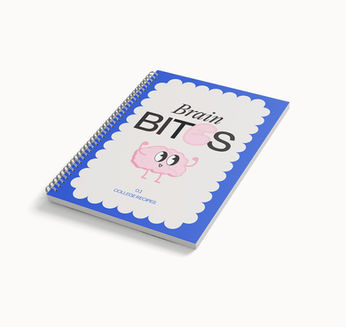
Brain Bites: A Student-Centric Cookbook
for Campus Dining
A branded product and marketing plan that improved accessibility for on-campus students, validated by user research and financial projections.
Project Overview
Team: 4 students
Role: Visual Designer & Marketing Strategist
Tools: Adobe Illustrator, Adobe InDesign, Figma, Google Forms, Excel
As part of a marketing consultancy project, our team developed a new product for FedEx Office that targeted first-year college students: Brain Bites, a cookbook bundled with pre-packed grocery kits. We created the brand identity, marketing plan, and prototypes,
validated through surveys and focus groups with students.
The Problem: Cooking on Campus is Inconvenient
Students living on campus, especially freshmen, often lack access to groceries and struggle to prepare meals. While campus dining offers meal plans, there was no product bridging the gap between convenience, affordability, and healthy eating.
Our research revealed:
-
Freshmen without cars have limited grocery options
-
Students want variety and convenience but also affordable solutions
-
Parents look for add-ons that support their student’s independence
Research & Discovery
We combined quantitative surveys (n=65) with a focus group of dorm-residing students.
Key Insights:
-
69.2% would purchase Brain Bites if integrated with dining plans
-
Most students wanted recipes rotated weekly (to avoid repetition)
-
Price sensitivity was strongest around $10–15
-
Allergy-friendly and seasonal recipe options increased appeal
We also conducted a stakeholder interview with a Campus Dining communications specialist, validating that 3 new recipes per week was feasible for operations.
My Role
I focused on the visual design and strategy components of Brain Bites:
-
Brand Identity: Designed the Brain Bites logo in Adobe Illustrator and co-developed the color palette + typography
-
Prototype: Built the physical cookbook mockup in Figma, including layouts for 35 recipes across breakfast, lunch, and dinner
-
Marketing Strategy: Authored the Company & Structure section of our marketing plan, aligning FedEx Office’s business with this new product line
-
Financial Planning: Produced the cost and revenue model, showing production cost ($4.75/book) and projected profit ($39,375)
-
Presentation Concept: Originated the “purchasing simulation” used in our final pitch to show how students would select recipes, pick up groceries, and cook meals
Iteration & Design
Visual Identity
We aimed for an approachable but bold design language. Fun for students, but professional enough to align with FedEx branding.
Prototype Mockup
The 4x6” cookbook was divided by meal type. Each recipe spread featured:
-
High-contrast photography
-
Ingredient lists formatted for speed
-
Step-by-step instructions optimized for beginners
Marketing Experience
In the purchasing simulation, students “chose” their top recipes via a survey, then were shown how they’d pick up a pre-packed bag from the campus market. This created an interactive and persuasive way to visualize adoption.
Impact & Results
-
Product Feasibility: Stakeholder confirmed scalability and pricing feasibility
-
Survey Validation: 69.2% said they’d purchase the product; 47.7% preferred weekly recipe rotations
-
Financial Projection: Revenue of $75,000 with profit margin of $39,375 based on Cal Poly’s student population
Reflection
This project pushed me to balance creative brand identity with business viability.
I learned how to:
-
Design with both user needs and financial constraints in mind
-
Translate survey data directly into feature decisions
-
Present concepts persuasively through interactive simulations
If extended, I would iterate on digital integrations (e.g., an app companion to the cookbook)
to better support recipe rotations and allergy filtering.




